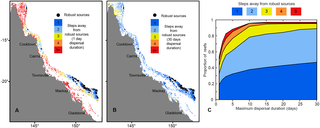PLOS Biology ( IF 9.8 ) Pub Date : 2017-11-28 , DOI: 10.1371/journal.pbio.2003355 Karlo Hock , Nicholas H. Wolff , Juan C. Ortiz , Scott A. Condie , Kenneth R. N. Anthony , Paul G. Blackwell , Peter J. Mumby

|
Australia’s iconic Great Barrier Reef (GBR) continues to suffer from repeated impacts of cyclones, coral bleaching, and outbreaks of the coral-eating crown-of-thorns starfish (COTS), losing much of its coral cover in the process. This raises the question of the ecosystem’s systemic resilience and its ability to rebound after large-scale population loss. Here, we reveal that around 100 reefs of the GBR, or around 3%, have the ideal properties to facilitate recovery of disturbed areas, thereby imparting a level of systemic resilience and aiding its continued recovery. These reefs (1) are highly connected by ocean currents to the wider reef network, (2) have a relatively low risk of exposure to disturbances so that they are likely to provide replenishment when other reefs are depleted, and (3) have an ability to promote recovery of desirable species but are unlikely to either experience or spread COTS outbreaks. The great replenishment potential of these ‘robust source reefs’, which may supply 47% of the ecosystem in a single dispersal event, emerges from the interaction between oceanographic conditions and geographic location, a process that is likely to be repeated in other reef systems. Such natural resilience of reef systems will become increasingly important as the frequency of disturbances accelerates under climate change.
中文翻译:

大堡礁的连通性和系统弹性
澳大利亚的标志性大堡礁(GBR)继续遭受飓风,珊瑚褪色和食珊瑚荆棘冠海星(COTS)爆发的反复影响,在此过程中失去了许多珊瑚覆盖物。这就提出了生态系统的系统弹性及其在大规模人口流失后反弹的能力的问题。在这里,我们发现GBR的大约100个珊瑚礁(约占3%)具有理想的属性,可促进受干扰区域的恢复,从而赋予一定程度的系统弹性并帮助其持续恢复。这些珊瑚礁(1)通过洋流与更广泛的珊瑚礁网络高度相连,(2)受到干扰的风险相对较低,因此当其他珊瑚礁枯竭时,它们很可能会提供补给,(3)有能力促进所需物种的恢复,但不太可能经历或传播COTS爆发。这些“健壮的礁石”的巨大补给潜力(可能在一次扩散事件中提供47%的生态系统)来自海洋条件和地理位置之间的相互作用,这一过程很可能会在其他礁石系统中重复出现。随着扰动频率在气候变化下加快,礁石系统的这种自然复原力将变得越来越重要。在其他珊瑚礁系统中很可能会重复的过程。随着扰动频率在气候变化下加快,礁石系统的这种自然复原力将变得越来越重要。在其他珊瑚礁系统中很可能会重复的过程。随着扰动频率在气候变化下加快,礁石系统的这种自然复原力将变得越来越重要。


























 京公网安备 11010802027423号
京公网安备 11010802027423号